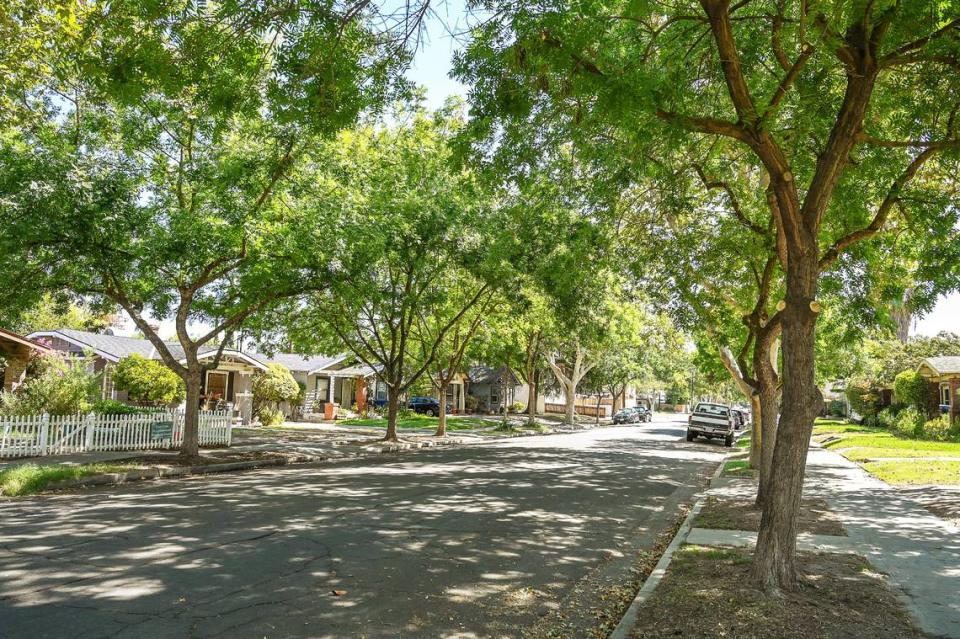Fresno’s urban forest plan aims for 80,000 new trees by 2065. Is that possible? | Opinion
Reality Check is a Fresno Bee series holding those in power to account and shining a light on their decisions. Have a tip? Email tips@fresnobee.com.
For decades, Fresno didn’t plant enough trees, planted the wrong types of trees and neglected its trees.
So now, city leaders have a ton of catching up to do and are compelled to make large investments in tree coverage and care.
Or else in several decades the “urban heat island effect” (a scientific term used to describe higher temperatures in cities due to direct sunlight reflecting off pavement and other surfaces) will be intolerable.
Even to residents who grow up with triple digits and terrible air.
Opinion
That’s my four-sentence summary of Fresno’s first comprehensive plan for publicly owned trees adopted by the city council during Thursday’s meeting. The 166-page Urban Forest Management Plan breaks down the current reality in great detail before establishing an “aspirational goal” of increasing the existing 14.6% citywide tree coverage to 20% over the next 40 years. (Neighborhoods in southwest, south central and near the airport score less than 5%.)
But in order to reach 20% coverage, which is considered fair at best, an average of 4,639 new trees must be planted on public property each year though 2065 — accounting for the expected annual loss of roughly 1,600 trees due to mortality and removal.
How large a number is 4,639 trees? It’s more than double the 2,253 planted citywide in 2023 following a June 2022 city council resolution to plant at least a 1,000 on an annual basis. Between 2019-22, according to the report, an average of 339 trees were planted.
Asked about the city’s ability to meet such a lofty target, Fresno City Councilmember Tyler Maxwell turned the question on its head.
“Here’s the thing: We’ve spent a quarter-million dollars and two years for a study to tell us we don’t have enough trees and where to plant them,” said Maxwell, whose district includes some of the city’s most barren neighborhoods.
“Now that we’ve adopted the study, we’re not going to follow it? That would be very ironic to me. I don’t see that we have a choice.”

Fresno’s current budget for trees is $4.1 million, about $2.8 million of which is allocated to the city’s contract with West Coast Arborists for routine trimming and maintenance. The 2022 council resolution also committed to a 10-year pruning cycle.
In order to meet the highest goal using the best management practices, the report’s authors say $16.7 million is needed.
Not to throw shade, but with city leaders about to square off over a $47 million budget deficit, a sudden 400% increase in funding for trees seems like a tall ask.
“It’s only ambitious because we’ve neglected our trees for so many years,” Maxwell said. “That it’s going to take us 50 years to increase our coverage by 5% says a lot about where our values have been as a city.”
Poor choices of trees
The forest management plan’s authors, environmental consultants from Dudek, presented several interesting findings. A couple were quite starting — and not in a good way.
For example, nearly 40% of the 131,732 individual trees growing in city parks and street medians belong to species poorly suited to climate change and Fresno’s hotter, drier future. The list includes five of the six most common types: crepe myrtle, southern magnolia, london plane, callery pear and coastal redwood.
By contrast, 31% belong to drought-tolerant species. Thank goodness Chinese pistache falls in that category because those trees account for a whopping 11.6% of the city’s inventory. Crepe myrtles are second at 8.3% — also far too many.

City leaders should do a better job of informing residents about this fact, the report states. As well as educating the public that watering an established tree costs about $2 per year.
Trees bring more benefits than can be grafted into a single sentence. They create aesthetically pleasing outdoor spaces, improve our air quality, provide shade when it’s hot and raise property values while lowering utility bills and crime rates.
None of this comes as a revelation, but for the first time city leaders possess a road map outlining the steps necessary for a more lush and equitable future.
For current and (especially) future residents of Fresno’s urban heat island, new values regarding the importance of trees must take root now.


